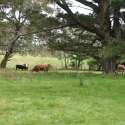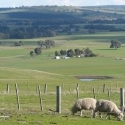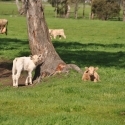27 Oct 2016
5 Production intensity and economics
Potassium for pastures
 Good pastures for cattle
Good pastures for cattle
The intensity of production will also determine the requirement for potassium fertiliser. The need for potassium fertilisers is greater in enterprises which have higher stocking rates or where nitrogen and phosphorous application, pasture renovation or improved grazing management have increased production. In each of these cases removal and transfer of potassium will be increased, often resulting in a potassium responsive situation.
For example, in New Zealand hill country at Te Kuiti, the long-term effects of nil fertiliser application have been compared to regular nitrogen and phosphorous application. Increased stocking rates have been possible on the fertilised paddocks to take advantage of higher pasture production and have subsequently led to improved profitability. After 13 years, applications of potassium were trialled on both areas to find that pastures responded to potassium applications in high input areas, but not in areas where nitrogen and phosphorous fertiliser had been withheld. This was probably due to increased potassium losses from animal transfer where production and stocking rates were higher. Most of the increase in pasture production was due to improved legume growth in potassium treated areas. (See table.)
The effect of applying potassium to annual pasture legume production (kg/ha/y) with differing phosphorus fertiliser histories.
K rate(kg/ha) | P fertiliser history | |
Nil P * | 23 kg P/ha/yr | |
0 | 361 | 1572 |
150 | 380 | 1910 |
This table shows the effect of applying potassium on annual legume production (kg DM/ha/year) on hill country with differing phosphorous fertiliser histories.
While responses to potassium fertiliser may be possible in many grazing situations, the economics of application may not always be favourable. For example, in extensive grazing systems, response to potassium application may only occur in years with a high pasture production potential (due to good rainfall). In these years pasture is already in abundant supply and animals may not be able to utilise the extra production generated by addition of potassium.
The economic benefits of improved production from fertiliser use must be captured through changes in management. If a grazier has the ability to manipulate stocking rates to improve pasture utilisation, or to conserve fodder, extra production due to the use of potassium fertilisers could prove profitable.
Furthermore, while it may be uneconomical to apply fertiliser over an entire property, investment in a few well managed paddocks can have excellent returns. Where part of a property is sown to more productive pasture species, fertilised with higher rates of nitrogen, phosphorous and sulfur, and stocked accordingly with high value livestock - for example, fat lambs or young cattle for sale - returns on potassium fertiliser application are likely.
In many regions, the local Grasslands society, government departments, fertiliser companies and farmers work closely together to determine the most economic production system for the region. This often involves the comparison between paired paddocks on individual farms which have been managed under 'normal' or 'high production' regimes. With many pairs of similarly managed paddocks the results of such trials can be significant across the whole region while still being applicable to individual properties.




